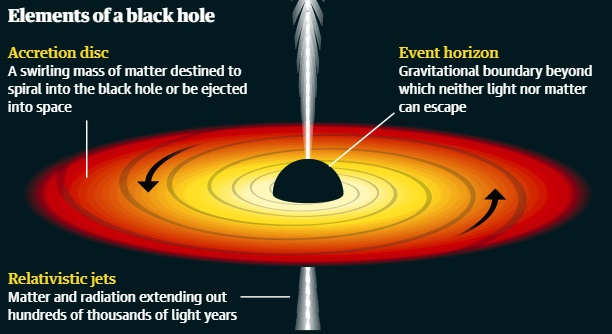Intermediate-Mass Black Holes | 13 Oct 2021
Why in News
Scientists from Chennai Mathematical Institute and Ors. have analysed data from the LIGO-VIRGO observatories and estimated the fraction of the binary Black Hole mergers detected so far that show potential to form Intermediate-Mass Black Holes.
Key Notes
- About Black Hole Mergers:
- It is the phenomenon of merging of two or more black holes.
- Indian scientists have already observed merger of three supermassive black holes.
- Merging of two or more black holes results in different types of black holes. For eg, Intermediate-Mass Black Holes and Binary Black Holes.
- Intermediate-Mass black hole (IMBH) is a class of black hole with mass in the range 102–105 solar masses: significantly more than stellar black holes but less than supermassive black holes.
- One of the theories of intermediate mass black hole formation has to do with ‘hierarchical growth’.
- That is, if the black holes exist among a dense cluster of stars, the remnant (black hole) of a merger can pair up with another black hole close by to form a binary. This can eventually merge to form a second remnant which is more massive. This process, happening in a hierarchical manner, can explain intermediate mass black hole formation.
- Gravitational Waves (GW) are created when two black holes orbit each other and merge.
- Kicks in Mergers:
- “Kicks” is the opposite momentum acquired by a remnant black hole during mergers. It is a reaction to Gravitational Waves taking away energy and linear momentum during mergers.
- These kicks can be quite large, giving it a velocity of up to 1000 kilometres per second.
- If this kick velocity is above the escape velocity of the star cluster in which the black hole is formed, it escapes from the environment and moves out. This hinders further hierarchical mergers.
- The extent of the kick received by the remnant can be calculated from the masses of the merging black holes and their spin. The kick estimates help understand which mergers have the possibility of forming Intermediate-Mass black holes.
Black Hole
- It refers to a point in space where the matter is so compressed as to create a gravity field from which even light cannot escape.
- The concept was theorized by Albert Einstein in 1915 and the term ‘black hole’ was coined by John Archibald Wheeler.
- Black holes form when a massive star undergoes a supernova explosion towards the end of its lifetime. The black hole forms from the remnants of the explosion.
- It is not necessary that a star at the end of its lifetime will become a black hole. As stars reach the ends of their lives, most will inflate, lose mass, and then cool to form white dwarfs. But the largest of them, those at least 10 to 20 times as massive as our own sun, are destined to become either super-dense neutron stars or so-called stellar-mass black holes.
- Usually, the black holes belong to two categories:
- One category is of Stellar black holes ranges between a few solar masses and tens of solar masses. These are thought to form when massive stars die.
- The other category is of supermassive black holes. These range from hundreds of thousands to billions of times that of the Sun from our Solar system. These are thought to form when two or more black holes merge.
- In April 2019, the scientists at the Event Horizon Telescope Project released the first-ever image of a Black Hole (more precisely, of its shadow).

